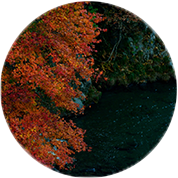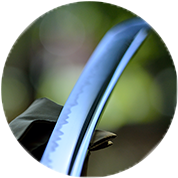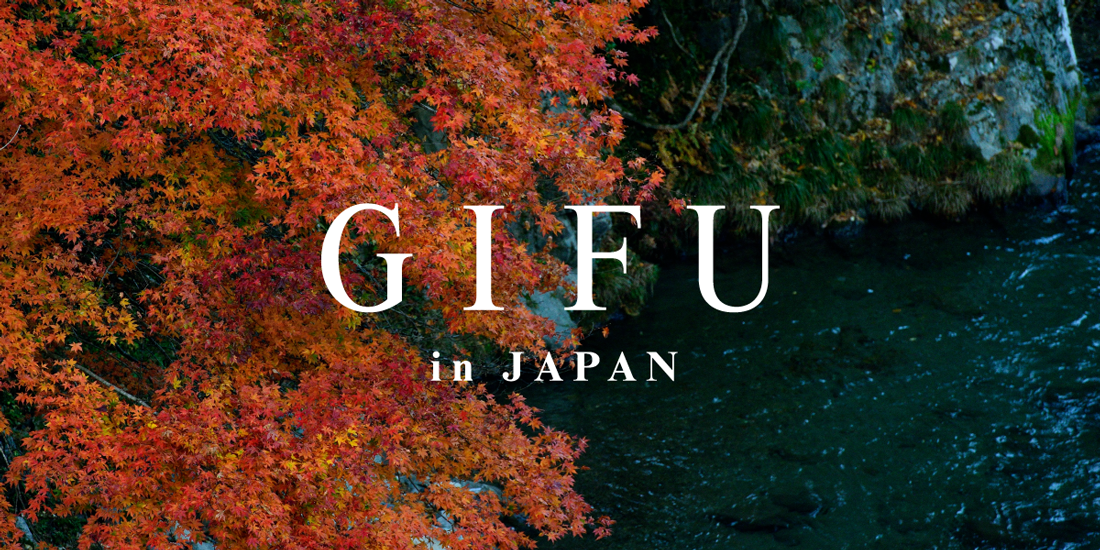



Craftsmanship in Gifu : Born from the Beauty of Nature
Gifu Prefecture is located almost in the center of Japan. For centuries civilization and culture have thrived here due to the abundant nature in the region. Crystal clear streams trickle down from the tall mountains that surround the prefecture. GifuŌĆÖs bountiful nature has lent inspiration to local craftsmenŌĆÖs creativity. During our time in Gifu, we examined how culture, tradition, and nature are intertwined.
The Nagara River runs from north to south through the center of Gifu. The beauty of the autumn leaves is breathtaking. The vivid red leaves stand in stark contrast to the crystal clear mountain water. 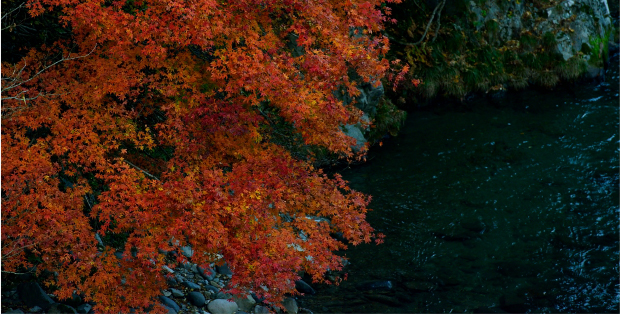

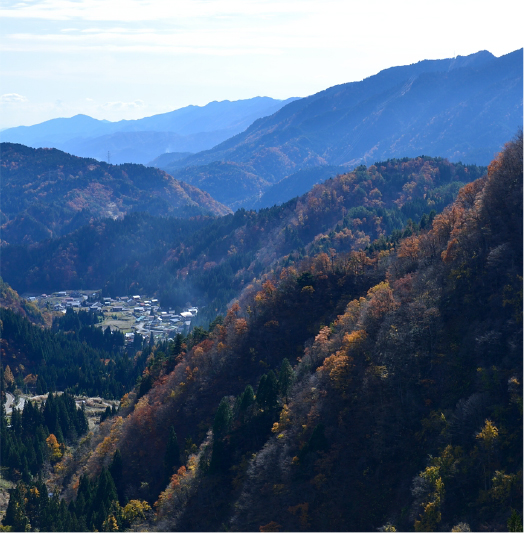 Scenery found along Route 314 while driving from Hakusan National Park to Gujo Shirotori. The town of Shirotori is visible at the bottom of the sloping mountains.
Scenery found along Route 314 while driving from Hakusan National Park to Gujo Shirotori. The town of Shirotori is visible at the bottom of the sloping mountains. The Amidagataki Waterfall, said to be the one of the sources of the Nagara River, is a sacred spot for people who worship at Mt. Hakusan. Worshippers meditate while sitting under the waterfall. 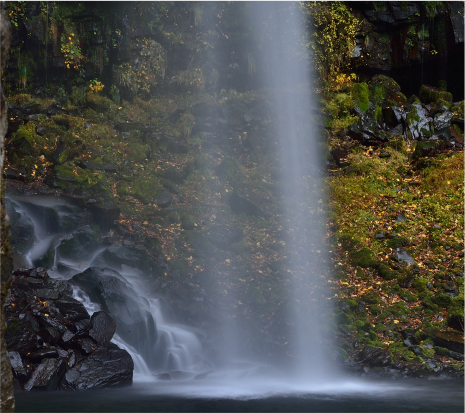

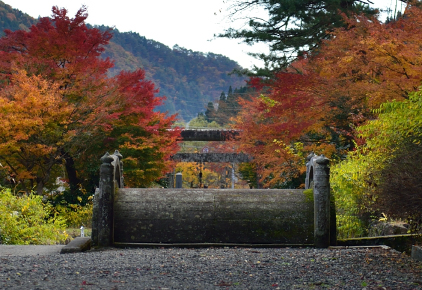 The ‘Dededen Festival’, an annual May tradition at Nagataki Hakusan Shrine, has been celebrated consecutively for over 350 years. People pray for abundant harvests and good health while running over the shrine’s stone bridge.
The ‘Dededen Festival’, an annual May tradition at Nagataki Hakusan Shrine, has been celebrated consecutively for over 350 years. People pray for abundant harvests and good health while running over the shrine’s stone bridge. -
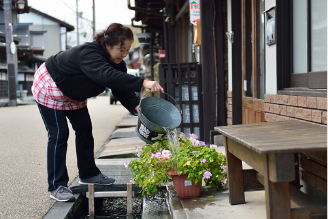 Gujo’s Shokunin-machi (Shokunin Town) is recognized by the Japanese government as an important historical treasure. Canals, built to aid in disaster prevention, run through the town. Water buckets, used to put out fires, hang in front of houses.
Gujo’s Shokunin-machi (Shokunin Town) is recognized by the Japanese government as an important historical treasure. Canals, built to aid in disaster prevention, run through the town. Water buckets, used to put out fires, hang in front of houses. -
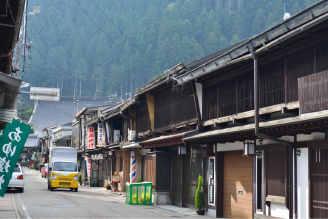 Beautiful, traditional houses line the street. The locals are responsible for keeping their town free of refuse. The streets are clean and free of trash.
Beautiful, traditional houses line the street. The locals are responsible for keeping their town free of refuse. The streets are clean and free of trash. -
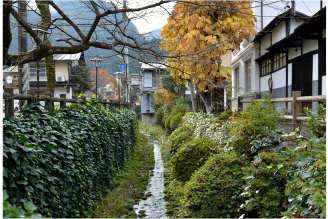 Natural spring water runs through town via irrigation canals. Locals used to use this water to do laundry and wash dishes. In the summer there are fish runs and locals lower watermelons into the canals to cool them.
Natural spring water runs through town via irrigation canals. Locals used to use this water to do laundry and wash dishes. In the summer there are fish runs and locals lower watermelons into the canals to cool them.
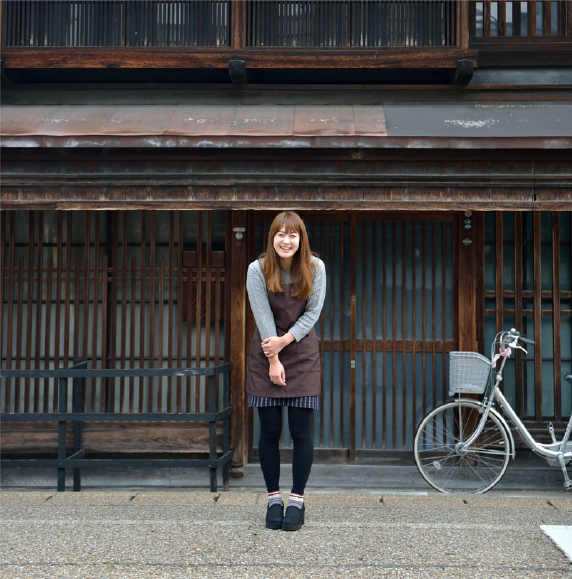 Mika Ueno, who we met on Main Street, works at the popular ‘Kokochi’ cafe which sits next to the Yoshida River. She is a true Gujo girl. She smiled happily as she told us how much she loves her town.
Mika Ueno, who we met on Main Street, works at the popular ‘Kokochi’ cafe which sits next to the Yoshida River. She is a true Gujo girl. She smiled happily as she told us how much she loves her town. 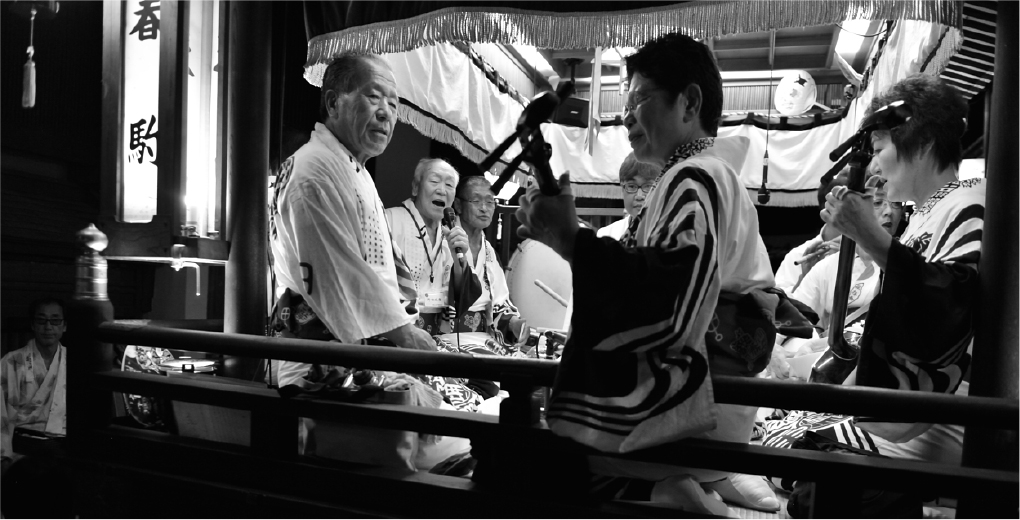
The Gujo Odori (Gujo Dance) is a traditional festival that has been celebrated in Gujo for more than 400 years. The festival begins in early July and lasts for two months. Participants dance all night long for four days during ‘Obon’ in Mid August. The musicians never stop playing.
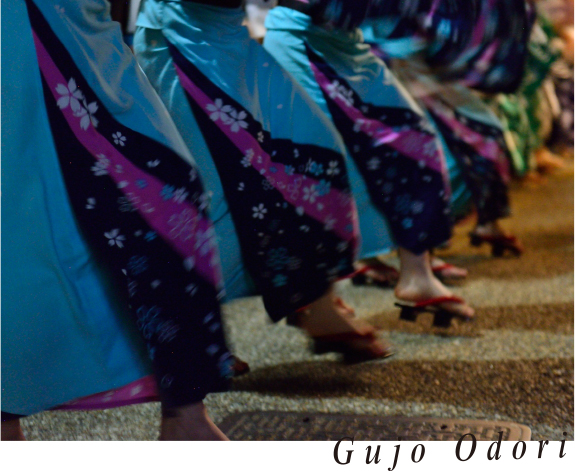 The Gujo Odori is one of the three largest ‘Bon festival dances’ in Japan. Yet, it is totally different from the others. Dancers come from all over the country and take their role very seriously. It is understandable why the foreign press describe the dancers as ‘being in a trance’. The town echoes with the clacking of geta (wooden clogs) and sweat drips from dancing bodies.
The Gujo Odori is one of the three largest ‘Bon festival dances’ in Japan. Yet, it is totally different from the others. Dancers come from all over the country and take their role very seriously. It is understandable why the foreign press describe the dancers as ‘being in a trance’. The town echoes with the clacking of geta (wooden clogs) and sweat drips from dancing bodies. Various companies and organizations come from all over Gifu to compete in the dance competition. When participants are judged, they receive a certificate that commemorates their preservation of the centuries old dance. 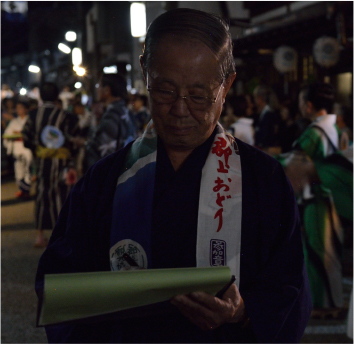

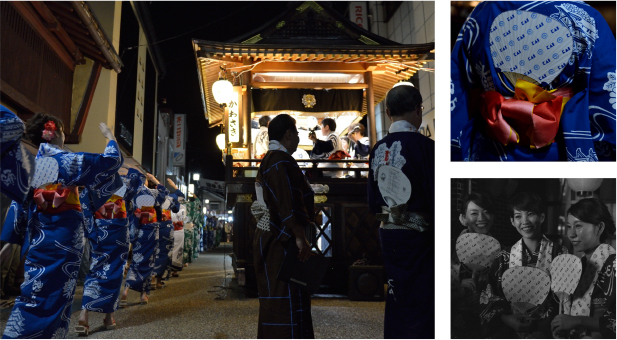 KAI employees who work in the company’s factories in Seki and Gujo compete as a group. Giving everyone blue fans and having them wear blue yukata strengthens group cohesion.
KAI employees who work in the company’s factories in Seki and Gujo compete as a group. Giving everyone blue fans and having them wear blue yukata strengthens group cohesion. 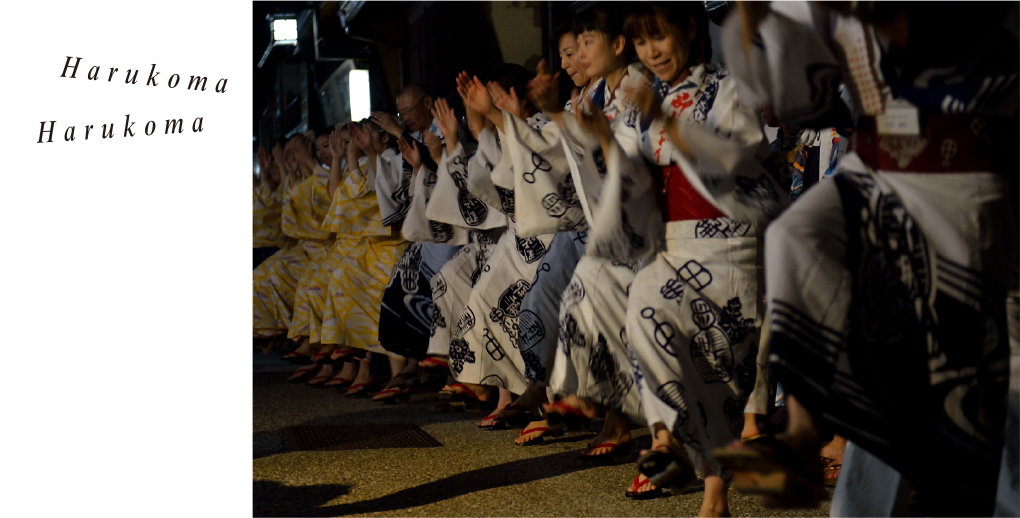 Gujo used to be known for its horses. The second song that dancers dance to is the ‘Harukoma’ (spring horse). The gallant movements mimic reining in a horse. The whole body is used in this relentless dance. Sweat pours down faces and bodies.
Gujo used to be known for its horses. The second song that dancers dance to is the ‘Harukoma’ (spring horse). The gallant movements mimic reining in a horse. The whole body is used in this relentless dance. Sweat pours down faces and bodies. The bountiful nature and old traditions inspire
the next generation of craftsmen.
80% of the land in Gifu Prefecture is forest. High quality wood has supported local crafters’ creativity. Nevertheless, very little of Gifu’s high quality wood is currently being used because there are few craftsmen. Yuto Morohashi started selling geta (wooden clogs), which are used in the historical Gujo Odori, after discovering that there were no geta, made in Gifu. Morohashi’s geta are made out of local Japanese cypresses. The straps are made from locally made silk screen printing cloth. They are truly traditional, locally made shoes meant for dancing all night long. His geta are carefully designed to showcase the beauty of the dance. The Gujo Odori, has also inspired the regional club scene. It could be argued that raves and dancing all night long can trace their origins back to the Gujo Odori. DJ MOTIVE, a music creator, released a remix of the Harukoma song, explaining: ‘I was impressed by the dynamic sounds of the Harukoma, one of the songs heard in the Gujo Odori.’ Kenji Sawaki spends his year tending a mulberry tree which is used to make Mino washi (Mino Japanese paper). It takes two weeks to make handmade Mino washi. Sawaki wistfully remarked : ‘I would like to pass on the art of Mino washi making to the next generation.’ Sakadachi Books, a local publisher in Gifu, published the magazine ‘Gifu No Mono’ (Products of Gifu) last year. The magazine spotlighted true craftsmen who care deeply about the production process. Its aim was to convey the earnest feelings of the craftsmen. The people of Gifu are said to be great craftsmen but poor businessmen. Despite this, they are simple and honest. They care about passing on important skills to the next generation. We saw a bright pride reflected in their eyes.
-
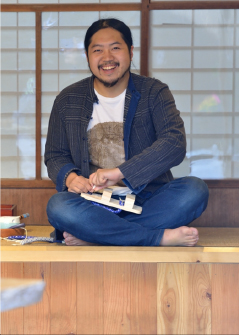 Yuto Morohashi, the owner of Gujo Mokuri, in Gujo Hachiman. He offers more than 50 different types of geta straps to choose from. GUJO MOKURI
Yuto Morohashi, the owner of Gujo Mokuri, in Gujo Hachiman. He offers more than 50 different types of geta straps to choose from. GUJO MOKURI
1-1 908 Hashimoto-cho,
Hachiman-cho,Gujo-shi,Gifu
0575-67-9235
http://gujomokuri.main.jp -
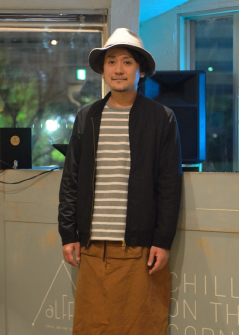 Aside from his Harukoma remix, DJ MOTIVE has also released an album, sampling birdsongs and the sounds of a river in the forests near Horado, an outlying suburb of Seki. ALFFO RECORDS
Aside from his Harukoma remix, DJ MOTIVE has also released an album, sampling birdsongs and the sounds of a river in the forests near Horado, an outlying suburb of Seki. ALFFO RECORDS
33 Miwa Building 2F
Hachiman-cho,Gifu-shi,Gifu
058-215-0798
http://www.alffo.info -
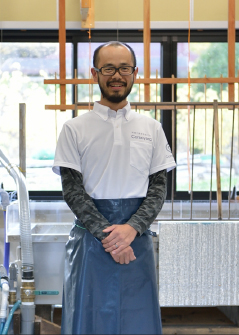 Kenji Sawaki, a Mino washi maker, runs the Corsoyard Factory. He enjoys making new products. He recently began selling Mino washi accessories. CORSOYARD
Kenji Sawaki, a Mino washi maker, runs the Corsoyard Factory. He enjoys making new products. He recently began selling Mino washi accessories. CORSOYARD
673-1 Tachibana,Mino-shi,Gifu
0575-35-1306
http://corsoyard.com -
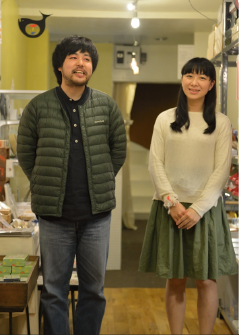 According to Handstand Books, we can only ‘see things by changing our point of view.’ Editor Asuka Yasuda (right), and art director Kohei Ishiguro (left). SAKADACHI BOOKS
According to Handstand Books, we can only ‘see things by changing our point of view.’ Editor Asuka Yasuda (right), and art director Kohei Ishiguro (left). SAKADACHI BOOKS
6-16 Kandamachi,Gifu-shi,Gifu
058-214-2566
http://sakadachibooks.com
Gifu | Article List
- Next FACT No.03
